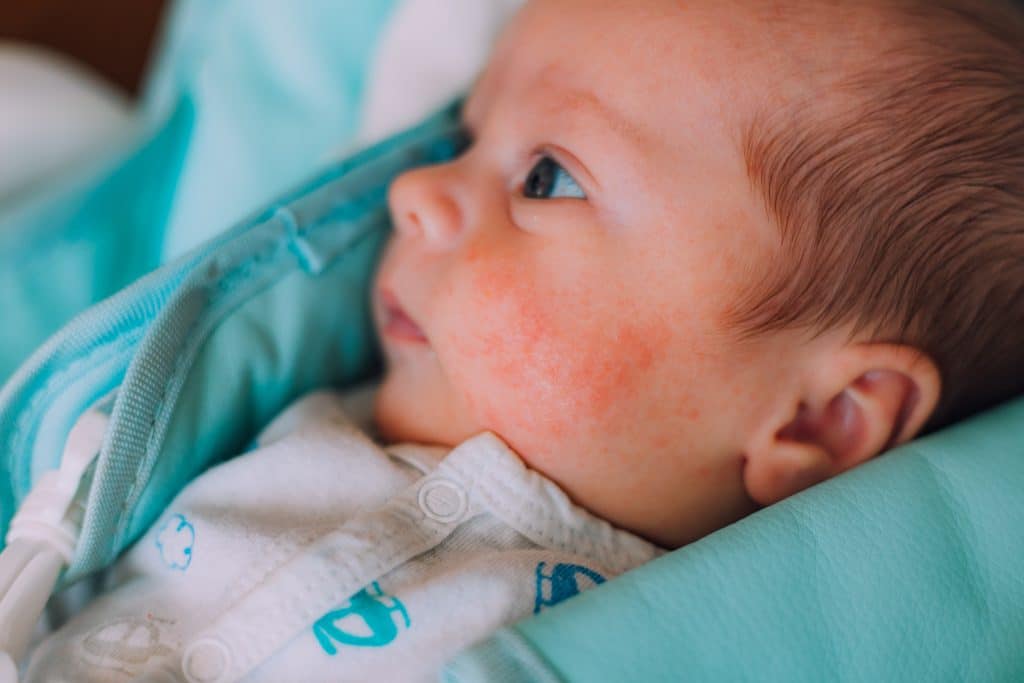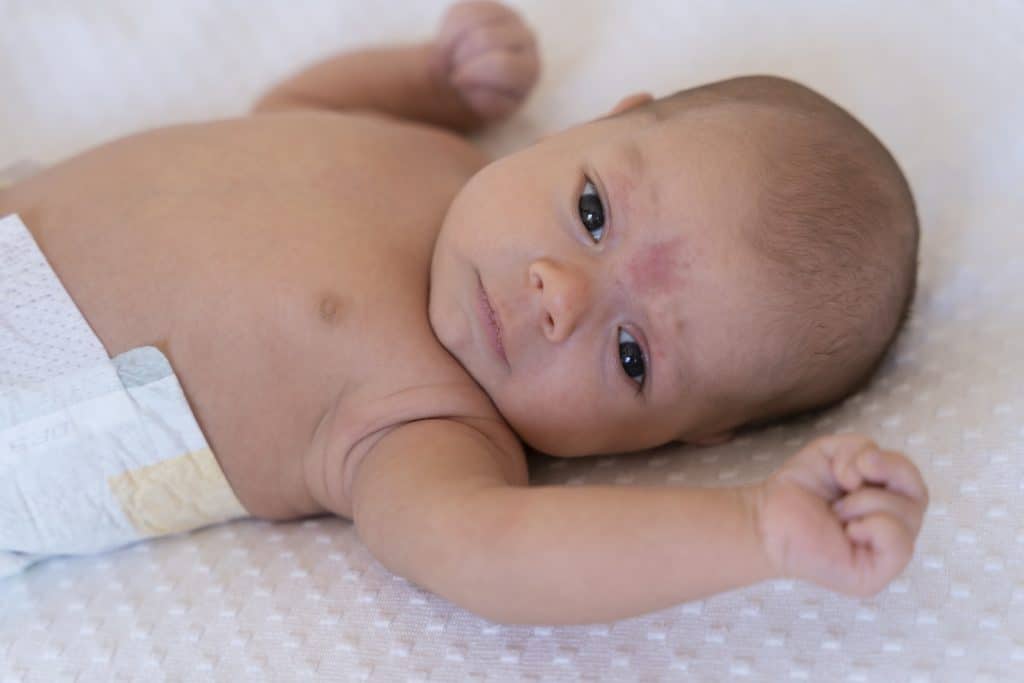Understanding Eczema in Small Babies: A Complete Guide
Eczema in small babies can be worrying for parents. The red, itchy patches on your baby’s delicate skin may leave you wondering what’s causing it and how to help. But don’t worry. With the right care, you can soothe your baby’s skin and keep them comfortable.
In this guide, we’ll explain everything you need to know about eczema in small babies. We’ll cover what it is, why it happens, how to manage it, and what treatments work best. Let’s start with the basics.

What Is Eczema / Infant Eczema?
Eczema, also called atopic dermatitis, is a skin condition. It causes dryness, redness, and itchiness. In babies, eczema often appears as red patches on the cheeks, forehead, arms, or legs. It can sometimes spread to other areas, like the torso or scalp. It’s not contagious, so you don’t need to worry about it spreading to others. Infant eczema or baby eczema typically starts between 2 and 6 months of age. It is a chronic condition, which means it can come and go. However, most babies experience periods of relief between eczema flare-ups.
Eczema isn’t just tough on babies; it can be stressful for parents too. You may feel helpless when your baby is uncomfortable or frustrated by persistent flare-ups. But remember, you’re not alone. Eczema is a manageable condition, and with the right steps, you can make a big difference in your baby’s comfort and well-being
Why Do Babies Get Eczema?
The exact cause of eczema isn’t known, but there are several factors that might contribute:
- Genetics: If you or your partner has eczema, asthma, or hay fever, your baby might be more likely to develop it.
- Weakened Skin Barrier: Babies have delicate skin. When their skin barrier is weak, moisture escapes, and irritants can get in.
- Environmental Triggers: Things like dust, pet dander, or even certain fabrics can irritate your baby’s skin.
- Allergies: Some babies may react to foods or products like soaps and detergents.
Signs of Eczema in Babies
Recognising eczema early can help you manage it better. Look out for these common signs:
- Dry, Scaly Skin: Your baby’s skin may feel rough or flaky.
- Red Patches: These are most common on the face, arms, and legs.
- Itchiness: Your baby may scratch or rub their skin, even in their sleep.
- Oozing or Crusting: In severe cases, the patches may weep or form crusts.
Tip: If you’re unsure whether your baby’s rash is eczema, consult your doctor. Early diagnosis is key.
When to See a Doctor
While most cases of baby eczema can be managed at home, there are times when you should seek medical advice:
- The eczema isn’t improving with treatment.
- Your baby has trouble sleeping due to itching.
- The skin is oozing, crusty, or showing signs of infection.
- You suspect a food allergy is triggering the eczema.
Your doctor may recommend specialised treatments or refer you to a dermatologist.
Top Tips to Help You Manage Eczema in Small Babies
Managing eczema requires a gentle and consistent approach. Here’s how you can help your baby feel more comfortable:
1. Keep Their Skin Moisturised
Moisturising is one of the most effective ways to manage eczema. Apply a gentle, fragrance-free cream or ointment several times a day. Also moisturise your baby’s skin after every bath and before bedtime.
2. Keep the Air Moist:
Keep their room comfortable by using a humidifier to add moisture to the air, especially in winter. This can prevent the skin from drying out.
3. Avoid Triggers
If a new product causes irritation, stop using it. Identify and eliminate anything that irritates your baby’s skin. This might include:
- Harsh soaps or shampoos
- Scratchy fabrics like wool
- Environmental allergens like dust or pollen
Foods can be another trigger. Monitor your baby’s diet and if you’re breastfeeding, avoid foods that might trigger allergies. Common culprits include dairy products, eggs, soy, and wheat. If you suspect a food allergy, consult your doctor or a dietitian. They can help you identify and manage any triggers.
4. Bathe with Care
Limit baths to 5-10 minutes and use lukewarm water. Hot water can dry out the skin. Add a mild, fragrance-free cleanser or emollient to protect their skin.
5. Dress Them Comfortably
Choose soft, breathable fabrics like cotton. Avoid tight clothing that could rub against their skin.
6. Prevent Scratching
Babies often scratch without realising. Keep their nails short and consider using mittens to protect their skin.
How to Treat Eczema in Babies
For mild eczema, home care is often enough. However, if the eczema is severe or doesn’t improve, consult a doctor. Here are some common treatments:
1. Over-the-Counter Creams
Look for creams with hydrating and soothing ingredients like glycerin or ceramides.
2. Prescription Medications
In some cases, your doctor may prescribe:
- Topical Steroids: To reduce inflammation.
- Antibiotics: If the eczema is infected.
- Antihistamines: To relieve itching.
3. Natural Remedies
Some parents find natural remedies helpful, such as:
- Oatmeal Baths: These can soothe irritated skin.
- Coconut Oil: A natural moisturiser that’s gentle on baby skin.
Caution: Always check with your doctor before trying new treatments.
How Bragan Skincare’s Atopic Cream Can Help
Managing eczema can feel overwhelming, but the right products make a big difference. Bragan Skincare’s Atopic Cream is specially formulated for sensitive skin, making it ideal for small babies with eczema. Our Atopic Cream isn’t just another moisturiser. It’s a multi-purpose solution designed to:
- Reduce redness and itchiness.
- Restore the skin’s natural barrier.
- Prevent future flare-ups.
It’s also:
- Gentle and Fragrance-Free: Perfect for delicate baby skin.
- Enriched with Snail Mucin: A natural ingredient that soothes, hydrates, and repairs the skin barrier.
- Restores the Skin Barrier: Helps lock in moisture and protect against irritants.
- Safe for Daily Use: Can be used as part of your baby’s skincare routine.
Parents love how quickly it works, and often report noticeable improvements within days. It also leaves their baby’s skin soft and smooth.
A Simple Skincare Routine with Bragan Skincare’s Atopic Cream
Here’s how to use Bragan Skincare’s Atopic Cream to keep your baby’s eczema under control:
- Cleanse Gently: Use a mild, fragrance-free baby wash during bath time.
- Apply the Cream: After the bath, pat your baby’s skin dry and apply a generous layer of Bragan Skincare’s Atopic Cream.
- Reapply as Needed: Use the cream whenever your baby’s skin feels dry or looks irritated.
- Protect Overnight: Before bedtime, apply the cream again to lock in moisture while your baby sleeps.

Real-Life Success Stories
Many parents have found relief for their babies through Bragan Skincare’s Atopic Cream. Here’s what they’re saying:
- “My baby’s skin was constantly dry and red, but this cream made a huge difference within a week!”
- “I love that it’s gentle and safe for everyday use. No more worrying about harsh chemicals.”
- “We tried so many products, but nothing worked like this. It’s a lifesaver for eczema flare-ups.”
Final Thoughts
Eczema in small babies can feel overwhelming, but with the right care, you can make a big difference. Stick to a gentle skincare routine, avoid triggers, and use effective products like Bragan Skincare’s Atopic Cream. This trusted cream, enriched with snail mucin, is a lifesaver for managing eczema and keeping your baby’s skin soft and healthy.
Remember, every baby’s skin is unique. Be patient and consistent, and don’t hesitate to consult your doctor for additional support. With time and care, your baby will enjoy healthier, more comfortable skin.
Take the first step today—try Bragan Skincare’s Atopic Cream and see the difference it can make!
Atopic Cream for Sensitive Skin
Our atopic cream is designed to treat skin conditions. These may be inherited or as a result of sensitivity to allergens such as soaps, detergents, stress and the weather. Made from snail mucin – a natural ingredient with a wealth of healing, hydrating, and anti-inflammatory properties. Our Atopic Cream is dermatologically tested and effective in treating chronic skin conditions including eczema, psoriasis, and dermatitis. It brings relief to those suffering from irritated or itchy skin, rashes and allergic reactions. Snail mucin also reduces scar tissue and stretch marks and is soothing for dry and sensitive skin. Incorporate snail mucin cream…
Featured Bragan Skincare Products
-
€39.99 – €100.00Price range: €39.99 through €100.00Select options This product has multiple variants. The options may be chosen on the product page
-
€100.00Select options This product has multiple variants. The options may be chosen on the product page


